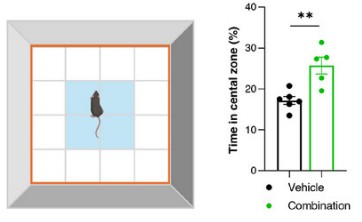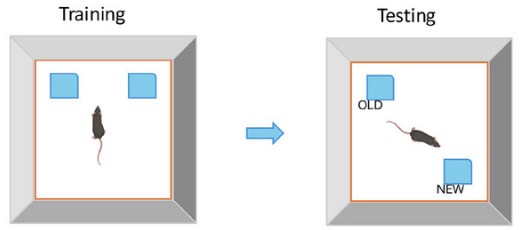Breakthrough Aging Clock Reveals Anti-Aging Drugs for the Brain
Scientists develop a new brain aging clock based on gene expression patterns in brain tissue from 778 individuals and apply it to identify drugs that rejuvenate the brain in aged mice.
Highlights
- Researchers applied their new brain aging clock to two types of neural cells, neurons and neural progenitor cells, to identify 478 compounds that rejuvenate these cells.
- Of these 478 compounds, the researchers selected three to test on aged mice: 5-azacytidine, tranylcypromine, and JNK-IN-8.
- Treatment with a combination of the three candidate compounds alleviated anxiety, modestly improved memory, and rejuvenated the brain, as measured with a gene activity analysis, in aged mice.
Historically, scientists have typically sought to identify compounds that rejuvenate crucial organs, such as the brain, based on their effect on certain sets of known cellular molecules or proteins. In this way, researchers have tested how increasing or suppressing the activation of such cellular molecules or proteins, using potential aging intervention compounds, affects organ function and ultimately, aspects of functional physiology, such as cognition. However, a key limitation of this method for testing aging interventions is that it takes a multitude of experiments, a lot of time, and substantial costs for labor.
As an alternative method to identify aging interventions, del Sol and colleagues from the Luxembourg Centre for Systems Biomedicine published a study in Advanced Science regarding a brain aging clock based on brain tissue gene activity data from healthy individuals aged between 20 and 97. The scientists then applied their brain aging clock to human neural cells to find which drugs reverse aging, as measured with gene activity pattern analyses, and in doing so, they pinpointed nearly 500 compounds. Then, del Sol and colleagues treated aged mice with a combination of the top three candidates from the nearly 500 identified compounds and found that they alleviated anxiety and modestly improved memory, as measured with behavioral tests, and rejuvenated brain tissue, as measured with gene activity analyses. These findings suggest that using this new brain aging clock could serve as a way to expedite the identification of aging intervention drugs that may slow neurodegeneration and preserve cognitive function during aging.
A Brain Aging Clock Identifies 478 Neural Cell-Rejuvenating Compounds
To create a brain aging clock, the Luxembourg-based researchers utilized whole-brain gene activity data from four different studies, ultimately using data derived from 778 cadavers. The individuals from whom the brain tissue gene activity data came were classified as healthy adults aged between 20 and 97 years.
del Sol and colleagues used an analysis of gene activity (known as transcriptomics) as a means to create their brain aging clock, because this method can provide insight into which proteins to target with potential aging intervention compounds. In that sense, gene activity changes with age, and the increased or decreased activation of genes roughly coincides with the levels of the proteins they code for. Thus, from transcriptomics data, matching compounds that activate or suppress certain genes to influence protein levels could serve as a way to measure their rejuvenative effects in brain tissue. Along those lines, changing gene activity patterns toward what they were at a younger age would suggest rejuvenation.
For the identification of compounds that may have brain-rejuvenating effects, del Sol and colleagues screened the effects of thousands of compounds on the gene activation patterns of two types of human neural cells, neurons and neural progenitor cells. Interestingly, some of these compounds have previously been found to extend lifespan in animal models.
As such, del Sol and colleagues compared gene activation data between neural cells derived from young individuals aged 18 to 30 years and older adults aged 70 and above. The researchers found that 411 of the compounds rejuvenated the gene activation patterns of neural progenitor cells and that 67 rejuvenated gene activity in neurons, making a total of 478 compounds.
Three Identified Compounds Alleviate Anxiety and Modestly Improve Memory In Mice
To find whether these identified compounds have any practical, brain-rejuvenating application, del Sol and colleagues treated aged mice with a combination of the top three identified compounds from the list of 478. These compounds were 5-azacytidine, tranylcypromine, and JNK-IN-8, all of which influence gene activation through their effects on molecular tagging patterns on DNA (known as epigenetic regulation).
Interestingly, 5-azacytidine, an FDA-approved chemotherapy drug used to treat a certain type of leukemia, also appeared in a database called DrugAge for its ability to extend worm lifespan. Moreover, tranylcypromine, also an FDA-approved drug, has a molecular structure similar to everolimus, an analog of the drug rapamycin (known to significantly extend mouse lifespan). Furthermore, JNK-IN-8, a drug not approved by the FDA, potently inhibits JNK proteins that play a significant role in the initiation and amplification of inflammation in humans.
When del Sol and colleagues treated aged mice with a combination of these three compounds, the mice displayed reduced signs of anxiety. In that regard, in an open field test, which entails placing a mouse in an open arena and monitoring its movement and behavior, mice treated with the combination of three compounds spent more time in the center of the arena. When mice have high levels of anxiety, they tend to spend more time on the outskirts of the arena, so this finding suggests that these three compounds alleviated anxiety.

To measure whether the three compounds affect memory, del Sol and colleagues subjected mice to a novel object location test. The novel object location test is used to assess mice’s spatial memory. It relies on the animal’s natural tendency to explore novel stimuli, specifically, the relocation of an object.
In that sense, in the test, mice first get accustomed to an arena with two identical objects. Then, on a day of testing, one of the objects is moved to a new location. Since mice naturally tend to explore an object moved to a novel location, the time the mouse spends exploring the object in the new location, compared to the object in the familiar location, is used to assess their spatial memory. Accordingly, a mouse with impaired memory would not remember the location of a familiar object, so it would spend more time exploring the familiar object and less time exploring the newly-placed object compared to a mouse with intact memory.
When del Sol and colleagues measured memory with the novel object location test, aged mice treated with a combination of the three candidate compounds exhibited trends toward improved spatial memory, spending more time exploring the object in a new location. Although not reaching statistical significance, these findings suggest that treatment with the three compounds modestly improves cognitive function, namely, spatial memory.

To find whether the three selected compounds rejuvenate the brain, as assessed with a gene activity analysis, del Sol and colleagues compared brain gene activity of mice treated with the combination of drugs to that of younger mice. The researchers defined a rejuvenative effect of the treatment as post-treatment gene expression patterns that move closer toward aligning with those of younger mice.
In that regard, treatment with the combination of drugs rejuvenated nearly half of the 493 genes found to exhibit altered gene activation with age. These findings support that a combination treatment with 5-azacytidine, tranylcypromine, and JNK-IN-8 rejuvenates the gene activation patterns of mice, which may help explain their reduced anxiety and the trend toward memory improvement.
“Altogether, these results show that a selection of compounds predicted by our clock to transcriptionally rejuvenate the brain indeed produce rejuvenation at the transcriptome level in aged mice, which translates into an improvement of the age-derived functional decline,” said del Sol and colleagues in their publication.
Testing Other Compounds Identified with the Brain Aging Clock
The most important aspect of the study seems to be the means that del Sol and colleagues used to identify the combination of compounds with cognition- and gene activity-related rejuvenative effects, the brain aging clock. Their brain aging clock, based on human brain tissue gene activity changes during aging, allowed the researchers to measure what compounds rejuvenate neural cells, as measured with the reversal of age-related gene activity patterns.
With this technique, del Sol and colleagues identified a multitude of compounds that may rejuvenate the brain, 478 in total. In that regard, a combination of only three of these compounds was tested in mice, and it conferred positive findings. Accordingly, this leaves 475 compounds that del Sol and colleagues identified with their model for future testing.
Importantly, researchers seeking to apply this brain aging clock for the identification and testing of other compounds can use the computational platform R, under the package “brainAgeShiftR.” Along those lines, this new brain aging clock could precipitate the identification of other compounds that facilitate the gene-activity-based rejuvenation of the brain, which could slow cognitive decline and possibly improve cognition in humans. Confirming the efficacy of any identified compounds using this brain aging clock will require future human trials before the FDA approves them. Altogether, though, the process of conducting human trials as well as FDA approval takes about 10 to 15 years.
The Brain Aging Clock Identified Three Possible Brain-Rejuvenating Nutraceuticals
As an alternative to waiting for FDA approval, del Sol and colleagues’ brain aging clock identified some nutraceuticals that can already be purchased. While del Sol and colleagues did not conduct experiments to confirm that these nutraceuticals rejuvenate the brain in aged mice, there is already animal model data suggesting that they improve cognitive function.
Accordingly, the three nutraceuticals identified with the brain aging clock applied to human neural cells are resveratrol, xanthohumol, and curcumin. In line with their experiments, these nutraceutical compounds were shown to rejuvenate human neural cells, as measured with a gene activity analysis.
Resveratrol is a plant-derived compound found in grapes, berries, and peanuts, and some evidence suggests it promotes the activity of enzymes called sirtuins that are involved in DNA repair and cellular metabolism. Moreover, xanthohumol is another plant-derived compound found in beer that has anti-inflammatory, antioxidant, and potential anticancer properties. Finally, curcumin is a bright yellow substance with antioxidant properties. If del Sol and colleagues’ model, which applies their brain aging clock to human neural cells, has translatability to humans, these three nutraceuticals could help slow neurodegeneration and rejuvenate the brain.
Model: 0.5 mg/kg of 5-azacytidine, 1.5 mg/kg of tranylcypromine, and 2 mg/kg of JNK-IN-8 injected intraperitoneally at a volume of 2.5 µL per gram of bodyweight twice per week for one month
Dosage: 18-month-old C57BL/6J mice

